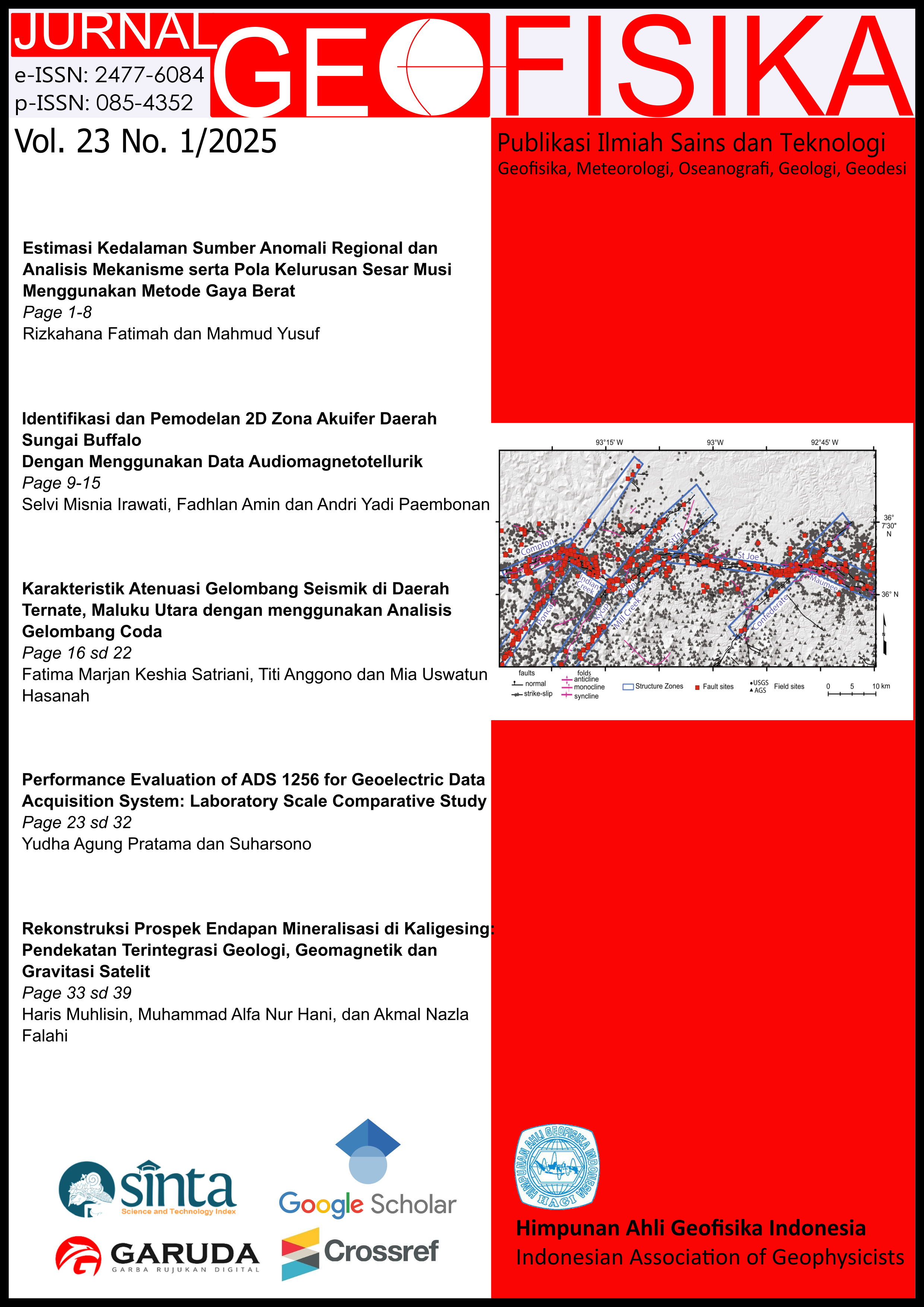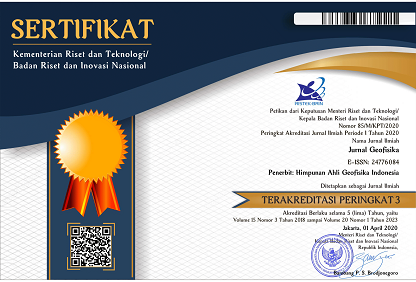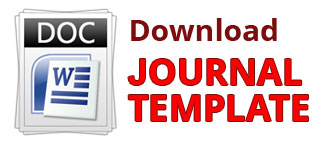Performance Evaluation of ADS 1256 for Geoelectric Data Acquisition System: Laboratory Scale Comparative Study
Keywords
ADS1256;, accuracy, geoelectricAbstract
The need of flexible and affordable geoelectric data acquisition systems is growing, particularly for research and educational purposes. This study aimed to evaluate the performance of a resistance measurement system based on the ADS1256 high-precision ADC module on a laboratory scale. Initial testing was conducted on a laboratory scale using various resistance values. The best accuracy was found in the medium to high resistance range R1 (subsurface target) (>10 Ω); at low resistance, the accuracy value decreased dramatically. A relative error (ε) reading of - 6.7% occured at low values of R1. The condition of the resistance R2 (surface) affected the stability of the ADS 1256 system reading. Based on the standard deviation value there was an indication of nonlinearity in the readings, particularly in the voltage readings. The current measurements produced relatively stable readings. There was an increase in the fluctuation of readings, especially at low surface medium (R2). Overall, the ADS1256 system demonstrated promising potential as a low-cost alternative for resistance measurement, particularly effective in the medium to high resistance range. Comprehensive data across all R1 and R2 variations require additional calibration and enhanced circuit stability to better align with reference values
References
Azharudin I., Imaddudin I., and Nuryadin B.W. (2013): Rancang Bangun Alat Geolistrik Untuk Menentukan Jenis Bahan Di Bawah Permukaan Bumi. Jurnal Kajian Islam, Sains dan Teknologi. Vol.7 no.1.
Carlo, L. D., Perkins, K., & Caputo, M. C. (2021). Evidence of Preferential Flow Activation in the Vadose Zone via Geophysical Monitoring. Sensors, 21(4), 1358. https://doi.org/10.3390/s21041358
Chen, Y., Huang, S., Huang, Q., Fan, Y., & Yuan, J. (2024). The Error Analysis of Bit Weight Self-Calibration Methods for High-Resolution SAR ADCs. IEEE Transactions on Very Large Scale Integration (VLSI) Systems.
Clément, R., Fargier, Y., Dubois, V., Gance, J., Gros, E., & Forquet, N. (2020). OhmPi: An open source data logger for dedicated applications of electrical resistivity imaging at the small and laboratory scale. HardwareX, 8. https://doi.org/10.1016/j.ohx.2020.e00122
Hartono, H., Abdullatif, F., Aziz, A. N., Sehah, S., Sugito, S., & Silalahi, S. P. (2022). Rancang bangun data logger berbasis Arduino sebagai penyimpan data. Jurnal Teras Fisika: Teori, Modeling, dan Aplikasi Fisika, 5(2), 23-27.
Huda F., Harmadi H., and Pohan A.F ( 2021): Prototipe Rancang Bangun Alat Geolistrik Menggunakan Arduino Uno R3 dan Transceiver nRF24L01+. Jurnal Fisika Unand vol 10. No 3
Hazreek, Z. A. M., Azhar, A. T. S., Aziman, M., Fauzan, S. M. S. A., Ikhwan, J. M., & Aishah, M. A. N. (2017). Forensic Assessment on Ground Instability Using Electrical Resistivity Imaging (ERI). Journal of Physics Conference Series, 790, 12038. https://doi.org/10.1088/1742-6596/790/1/012038
Indarto, B., Sudenasahag, G. R., Rahmad, D. B., Basri, M. H., & Sunarno, H. (2016). Rancang Bangun Sistem Pengukuran Resistivitas Geolistrik dengan menggunakan Sumber Arus Konstan. Jurnal Fisika dan Aplikasinya, 12(2), 83-89.
Kuklin, D. (2020). Device for the field measurements of frequency-dependent soil properties in the frequency range of lightning currents. Review of Scientific Instruments, 91(11). https://doi.org/10.1063/5.0012126
Loke, M.H. (2010): Res2Dinv ver. 3.59 for Windows XP/Vista/7, 2010. Rapid 2-D Resistivity & IP Inversion Using the Least-Squares Method. Geoelectrical Imaging 2D & 3D Geotomo Software 2010, Malaysia.
Loke, M.H. (2021): Tutorial : 2-D and 3-D electrical imaging surveys. Geoelectrical Imaging 2D & 3D Geotomo Software.
Morris, A. S. (2001). Errors during the measurement process. In Elsevier eBooks (p. 32). Elsevier BV. https://doi.org/10.1016/b978-075065081-6/50004-7
Nasution M.I., Lubis L.H., and Ramandan T.S. (2023): Rancang Bangun Resistivity Meter Berbasis Arduino Uno Dilengkapi Dengan Data Logger Sebagai Penyimpan Data. Navigation Physics: Jurnalof Physics Education. Vol. 5 no 2 (2023).
Rahman A., Nurfalaq A., and Manrulu R. H. (2025) Rancang Bangun Alat Ukur Resistivitymeter Berbasis Arduino. Applied Phsyics of Cokroaminoto Palopo Journal, vol 6. No.1
Rabinovich, S. G. (2005): Measurement errors and uncertainties, Theory and practice (3rd ed.). Springer.
Saad, R., Nawawi, M., Muztaza, N. M., Jusoh, Z., Yahya, A. K., & Alam, S. (2010). Testing Of Resistivity Imaging Method with Different Protocols to Detect Void Using Miniature Model. AIP Conference Proceedings, 177. https://doi.org/10.1063/1.3469629
Setiawan D.G.E., Prayatman R. and Tansa S. (2024) Design of Resistivity Meter Data Storage System Based on Arduino Mega 2560 Laboratory Scale Measurement Results. Indonesia Journal of Applied Physics. Vol. 14, No. 1. Fisika UNS.
Stein, M., Haselberg, R., Mozafari‐Torshizi, M., & Wätzig, H. (2019). Experimental design and measurement uncertainty in ligand binding studies by affinity capillary electrophoresis. Electrophoresis, 40(7), 1041. https://doi.org/10.1002/elps.201800450
Widodo W., Lapanporo., Jumarang M.I., B.P. (2018): Rancang Bangun Alat Geolistrik Berbasi Arduino Mega2560. Phsiscs Communication 2 (1) Unnes. pp 52-62.
https://doi.org/10.15294/physcomm.v2i1.12748
White, G. (2008). Basics of estimating measurement uncertainty. PubMed.
https://pubmed.ncbi.nlm.nih.gov/18852859
Zhao, R., & Anderson, N. (2018). A Description of Field Setup and Common Issues in 2-D Electrical Resistivity Tomography Data Acquisition. International Journal of Science and Research (IJSR), 7(12), 1061. https://doi.org/10.21275/art20193810
Zohra-Hadjadj, F., Laredj, N., Maliki, M., Missoum, H., & Bendani, K. (2019). Laboratory evaluation of soil geotechnical properties via electrical conductivity. Revista Facultad de Ingeniería Universidad de Antioquia, 90, 101. https://doi.org/10.17533/udea.redin.n90a11

This work is licensed under a Creative Commons Attribution 4.0 International License.
The copyright of all articles belongs to the authors. All other copyrights is held by the Journal











